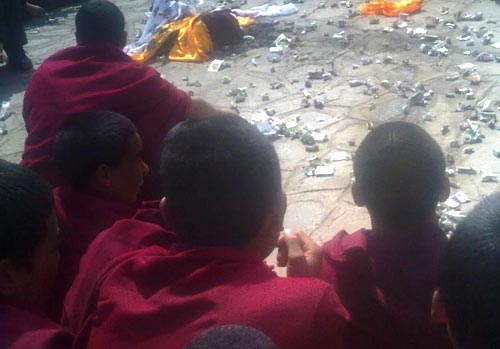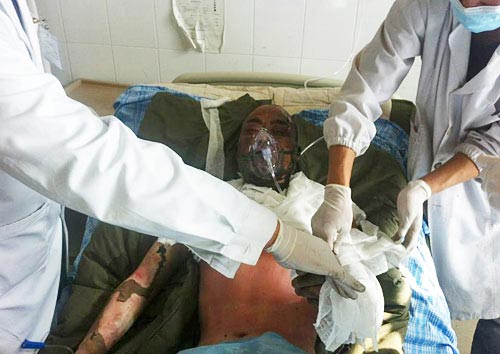
Monks from Lamu Dechen monastery in Malho, Qinghai, burning incense on March 10.
Despite an intense military buildup and restrictions in the area today, rare footage and images emerged of Tibetans praying at the scene of the self-immolation, followed by protests calling for the Dalai Lama to be allowed to return home. The images circulated among Tibetans on Facebook and can be viewed online on the website of Voice of America Tibetan Service.
Further news reached ICT from the area of:
- A commemoration of the March 10 anniversary of the 1959 Tibetan Uprising (and the 2008 protests) by monks at the historic Lamu Dechen Monastery in Chentsa, Malho (Chinese: Huangnan) Tibetan Autonomous Prefecture, Qinghai, which is now under lockdown. Images have reached ICT of an incense ceremony by the monks on March 10
- A demonstration by hundreds of students in the streets of Tsekhog (Chinese: Zeku or Zekog Xian) also in Malho, Qinghai, today. The students were calling for freedom to speak their own language, equality of nationalities, and an end to the intense military buildup in Tibet. The authorities have said that the Tibet situation is “a war against secessionist sabotage”, and the climate of fear and level of intimidation has intensified tensions (Tibet Daily, February 10, 2012).
Self-immolation of Jamyang Palden
Jamyang Palden, a monk in his thirties from Rongpo monastery in Rebkong (Chinese: Tongren), Qinghai (the Tibetan area of Amdo), set fire to himself this morning. It is the first self-immolation in Rebkong, and the 28th in Tibet since February, 2009. Jamyang Palden survived the self-immolation, but his condition is serious, according to Tibetans in exile in contact with those in the area.
Jamyang Palden was born in Lang Gyapo Township in Rebkong, which is in Malho (Chinese: Huangnan) Tibetan Autonomous Prefecture in Qinghai Province. A Tibetan friend of his who is now in exile said: “We were at the same monastery some years ago, and I remember him as a truly hard-working and humble monk. He was a very good monk. I remember hearing him reading his texts at night, he was always very conscientious, and was a role model for all of us. Some monks often used to talk about politics, including me, but he never did, he always talked about religion. Of course he used to talk about His Holiness, we all did. But I have not seen him for many years; I know that things changed dramatically and became much worse after 2008. It must be very hard to survive now. There is so much surveillance, it is impossible to even take a breath, impossible to express oneself. I don’t know what was in his mind [before he set fire to himself]. When you are 19 or 20 and you take some actions, you don’t really think it through, about the consequences. But at his age, in his early thirties, and given his character, he must have thought through what he was going to do.”
Jamyang Palden set fire to himself in Dolma square, near Rongpo monastery, which is the main monastery in Rebkong. Monks and local people took him to hospital, but it seems that he has since been moved back to the monastery. Despite the buildup of troops, images from Rebkong today show local people gathered at the scene of his self-immolation, quietly praying for him. The gathering led to a peaceful protest, with Tibetans calling for the Dalai Lama to return to Tibet. There are fears for the safety of Tibetans in Rebkong due to the military buildup following the self-immolation.
Rongpo (also known as Rongwo) is the administrative center for Rebkong county, and the monastery is an ancient center of Tibetan religious tradition, founded in 1301. There are around 35 branch monasteries at Rongpo, which was known for its expertise in Tibetan medicine and painting.
Rongpo was the site of a peaceful protest on April 17, 2008, when monks demanded the release of monks detained during the initial wave of protests a month previously. Just over a year later, one of the monks, 43-year old Sheldrup, who had been detained as a result of the protests, committed suicide following torture in custody. (ICT report, Official acknowledgement of suicide of monk after protests due to ‘stress’)

People at the site where Jamyang Palden was self immolated on the ground in front of the Rongpo monastery named “Dolma Square”.

Jamyang Palden receiving medical treatment from the local individual doctors at Rongpo.
Students protest in Malho
According to Tibetan sources in exile, hundreds of students from at least two schools in Tsekhog (Chinese: Zeku or Zekog Xian), Malho, Qinghai, marched to the county government office, with some carrying banners. The students were calling for freedom to speak their own language and equality of nationalities; non-confrontational and moderate requests that were also made in 2010 by students and teachers in Qinghai in a series of peaceful demonstrations in Rebkong and Chabcha, and also in Beijing (ICT report, Protests by students against downgrading of Tibetan language spread to Beijing).
In the first known and specific reference to the military buildup in Tibet since the self-immolations and connected unrest began, the students also apparently called for an end to the intensified security in Tibetan areas. Following the self-immolations and unrest, the Chinese authorities have strengthened the stifling and oppressive measures and presence of paramilitary troops that contributed to the acts in the first place, deepening the climate of fear in Tibetan areas – and increasing the danger of further self-immolations.
Tsekhog is nearly 100 km from Rebkong in the same prefecture and the protest apparently occurred later in the day, after the self-immolation of Jamyang Palden.
Bold religious commemoration of Uprising Day; monastery under lockdown
The Lamu Dechen monastery in Chentsa (Chinese: Jianza) county also in Malho is currently under lockdown following a bold and peaceful religious commemoration on March 8-10. According to Tibetan sources in exile in contact with people in the area, monks at Lamu Dechen created butter sculptures (a traditional form of offering) of the Dalai Lama and also of the Tibetan ‘snow lion’ flag, which is banned in Tibet. The monks and local people were seeking to mark a specific prayer festival, as part of an endeavour to maintain specific local traditions.
On March 10, the day that the Tibetan Uprising of 1959 is commemorated, at least 50 monks from the Lamu Dechen monastery gathered together to burn incense in front of the monastery. According to the same sources, during the gathering, monks called for the Dalai Lama to be allowed to return to Tibet, and for freedom. They began to march towards Chentsa county town, around 25 kilometers away.
A Tibetan source from Amdo who is in exile said: “Many local men and women, both old and young, saw them and came to request the monks to stop the march, fearful of a crackdown. When they spoke they had tears in their eyes. The monks did not carry on any further. Even so, that afternoon, more than five military trucks full of armed personnel arrived at the monastery, and the current situation there is not known.”
Lamu Dechen monastery is the largest in Chentsa county, located on a ridge south-east of the county town amidst Tibetan farming villages.

